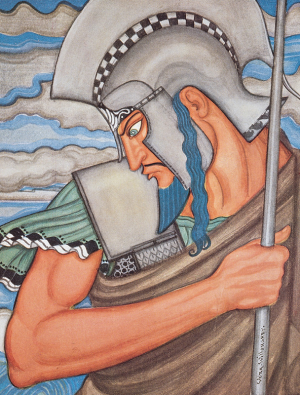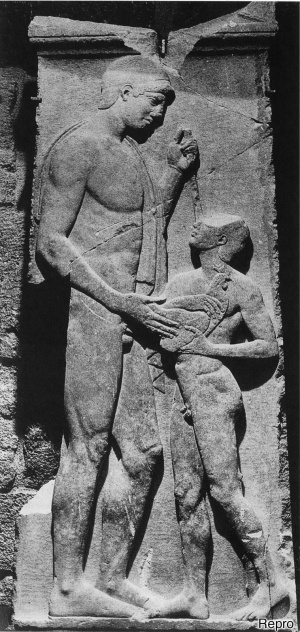(Boylove Documentary Sourcebook) - A Verbal Reminder of the Oath Sworn by Gnathios, an Ancient Greek Warrior, to His Young Male Beloved, in the Epitaph Inscribed on the Former's Tombstone: Difference between revisions
From BoyWiki
Created page with "thumb|center|<i>Philippides</i> by Willoughby Vera. Illustration from <i>A Vision of Greece</i> (1925). From <i>Ancient G..." |
Modified the caption of an image |
||
| Line 19: | Line 19: | ||
[[File:Gravestone Showing Youth And Boy As Lovers.jpg|thumb|center| | [[File:Gravestone Showing Youth And Boy As Lovers.jpg|thumb|center|Ancient Greek marble grave stele with relief depicting a scene of pederastic courtship in which a youthful [[erastes]] offers a rooster as love gift to a boyish [[eromenos]]. Rhodian, Severe Style, Early Classical Period, c. 465 BCE. Rhodes, Archaeological Museum, Palace of the Grand Master of the Knights, Γ 1640.]] | ||
==See also== | ==See also== | ||
Latest revision as of 03:34, 27 August 2021

From Ancient Greece: Social and Historical Documents from Archaic Times to the Death of Alexander the Great, Third Edition, edited by Matthew Dillon and Lynda Garland (London; New York: Routledge, 2010). First edition published in 1994 by Routledge.
4.75 Inscriptiones Graecae I3 1399: An Oath for Love of a Boy
A slab of marble from the Attic countryside, with crude archaic lettering, c. 500 BC, recording the heroic love of Gnathios for a younger boy, for whom he swore an oath that he would go to war; the boy presumably erected this as a memorial to Gnathios. [IG I2 920.]
Here a man swore a solemn oath for love of a boy
To mingle in strife and tearful war.
I am sacred to Gnathios, who lost his life in war ...

See also
- Adult friend
- Athenian pederasty
- Boylove
- Cretan pederasty
- Ephebophilia
- Greek love
- Historical boylove relationships in ancient Greece
- Loved boy
- Minor-attracted person (dictionary)
- Pedophilia
- Philosophy of ancient Greek pederasty
- Theban pederasty
- Young friend